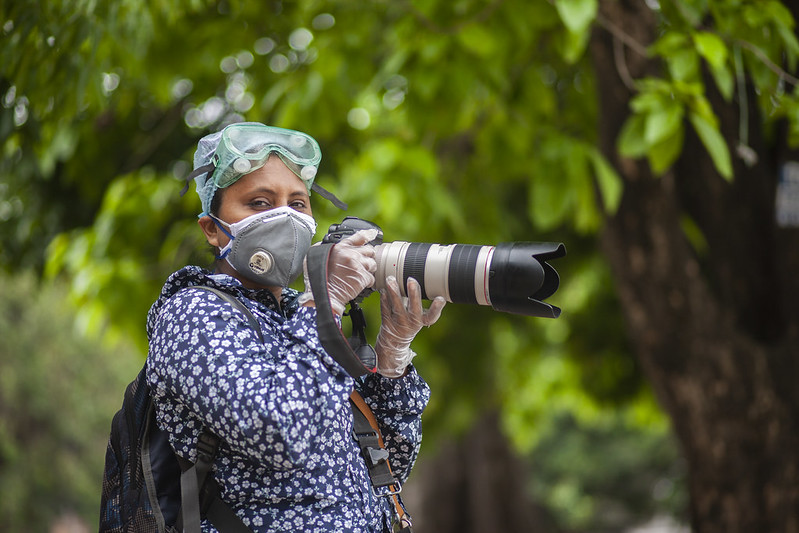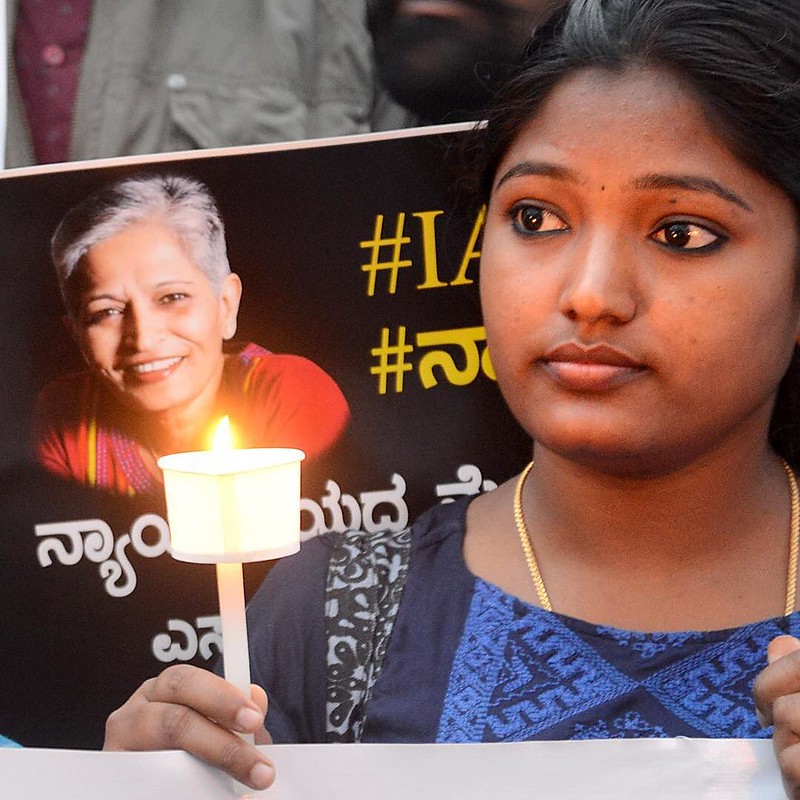In just the first half of 2020, The Coalition For Women In Journalism documented 25 major organized trolled campaigns targeting women journalists—a visible growth in comparison to 17 cases in the respective period last year.

Every reporter reckons with the fact that chasing a certain story can make them a walking target and eventually put them in danger. For women journalists, this sort of a natural work-related risk is accompanied by enormous challenges and pressures strictly related to their gender.
Such despicable attacks are deeply rooted in patriarchal structure and aim to silence women’s voices. So far in 2020, The Coalition For Women In Journalism (CFWIJ) has documented 267 cases of attacks and threats against women journalists.
While the type of threats varies depending on the region and specific conditions of each country, one must admit that the major problem that has emerged in recent years is online trolling. For the overwhelming majority of women journalists, it has become a hazard inseparable from the job. Numerous studies show that women reporters are more vulnerable to online harassment compared to their male counterparts.
Moreover, women receive a kind of hate that will never target men—attacks focused not on content, but on the journalists themselves. They regularly encounter vicious messages about their appearance and sexuality. They receive death and rape threats and in some extreme cases, their addresses and personal phone numbers are published online—a practice known as doxing.
Trolling on the Rise
While many seem to minimize the problem, CFWIJ has been carefully monitoring the complexity of online abuse for the past three years. CFWIJ gathers data, coordinates support networks for journalists, issues daily statements, calls upon the authorities and organizes events which aim to shed a broader light on this challenge.
In just the first half of 2020, we documented 25 major organized trolled campaigns targeting women journalists—a visible growth in comparison to 17 cases in the respective period last year. This is just a tip of the iceberg, as the statistics cannot possibly consist of a solid dose of sexualized and hateful comments that female reporters see daily on their social media.
Additionally, our research shows that women of color are 34 percent more likely to be mentioned in abusive or problematic tweets than white women. Black women are disproportionately targeted, being 84 percent more likely than white women to be mentioned in such tweets. Trolling therefore goes along not only with sexist but also racist rhetoric.
Online harassment stems from various factors such as inaction of politicians to polarization in society and has severe consequences which impact both mental and physical health of women journalists, pushing them into isolation and self-censorship. The gravity of the issue and our dedication to profoundly analyze this phenomenon were spurs to launch a series of awareness campaigns called #ThreatsToWIJ.
#ThreatsToWIJ Campaign
CFWIJ first launched the #ThreatstoWIJ campaign in 2017, when journalist Gauri Lankesh was killed in India.

The year 2020 called for a re-invoking of this campaign’s second edition with special focus on Pakistan. Our campaign was triggered by the brutal murder of Baloch journalist Shaheena Shaheen and the incessant online trolling of women journalists in this country: They encounter vicious social media attacks, doxing and hacking attempts by accounts often affiliated to the ruling party and conservative, right-wing constituents.
Trolls regularly spread hatred, sexist slurs and rape “jokes” against remarkable women journalists like Marvi Sirmed, Gharidah Farooqi, Tanzeela Mazhar and Asma Shirazi—to mention a few.
In particular, CFWIJ has been continuously supporting Sirmed as she has been subjected to various types of threats and violence for decades. Her house was devastated multiple times and she herself has been slut-shamed and labelled with sexist and racist expletives.
It’s an extreme and horrifying example, yet unfortunately not a rare one. A survey among Pakistani journalists by Digital Rights Foundation (DRF) showed that 72 percent of women respondents had experienced “digital insecurity” such as being hacked, threatened, blackmailed and being harassed.
CFWIJ has been taking numerous steps in order to support women journalists in their quest for a fair treatment and safer working environment.
Last year in July, our delegation met with Dr. Shireen Mazari, Pakistan’s human rights minister, to demand swift actions against trolling and present a resolution for the protection of women journalists.
Earlier this year, CFWIJ joined multiple statements condemning online harassment and #AttacksWontSilenceUs campaign organized by Pakistani journalists which all showed the enormous scale of these practices.
The lack of concrete actions from the authorities proved the need to emphasize the danger of these threats even more. During the #ThreatsToWIJ Pakistan-focused campaign, we were joined by experienced and respected journalists who have personally been affected by online threats. Our goal was to give a platform to journalists worldwide so they could share their experience while talking about potential remedies.
Different Backgrounds, Similar Experiences
We realize every day that being an organization which speaks loudly about online harassment puts us in a spotlight, and we are not free from such attacks either.
On September 25, we organized a webinar where we discussed online trolling and cyber-attacks in Pakistan with journalists from our network. We encountered mysterious accounts that wanted to jeopardize our event and join the discussion in order to share highly inappropriate and sexualized content.
As a result, we received many requests to take this discussion to the next level. Thus, we have decided to launch a global campaign which took place on September 22. The discussion was fueled by numerous powerful voices from all around the world.
Before the campaign, CFWIJ did a regional breakdown to assess trends of threats against women journalists worldwide in order to better understand specificity of each region. We wanted to point out that even though journalists in Europe, Latin America or Middle East may face different problems when it comes to suppressing press freedom, political pressure, threats from extremist groups and cartels or old-fashioned sexism in the newsrooms, there is something disturbingly egalitarian about online trolling as it targets women’s voices worldwide.
Online harassment is a crime very difficult to track—which means it often goes overlooked. In the Middle East. CFWIJ has documented over 70 threats against women journalists in the MENA region since the beginning of 2020. Yet only eight of them were classified as online threats.
The lack of solid documentation might be due to victim-shaming culture based on patriarchal society structure, which forces women journalists to stay silent about online attacks and crackdown on social media.
One participant of our global campaign, journalist Faranak Amidi admitted that personal attacks are very common: “Bullying in forms of belittling, sexually degrading comments, rape threats and such are an almost daily experience.”
Constant harassment even led to her decision to deactivate her Twitter account for a while.
Another unsettling example comes from journalist Sanar Hasan. Following the translation of an article about the activity of Popular Mobilisation Forces (PMF), Hasan and her team started to receive online threats. In turn, Sheena Shirani quoted a survey which finds that 90 percent of women reporters in Iran have experienced some sort of sexual harassment during their careers.
Consequences for Mental Health
Mental health is often overlooked among women journalists, but has been highlighted throughout the campaign for its correlation to online trolling. CFWIJ has been reiterating the need to address this issue and supports the idea of organizing workshops focused on mental wellbeing for female reporters. The discussion showed that there is a strong need for that.
Carly Robinson, a video journalist at City News Edmonton, admitted that in many cases women journalists, herself included, will choose to leave their names or Twitter handles out of web descriptions of contentious stories.
“We don’t care about missed followers or credit on big stories, because we can sleep better without our phones blowing up with threats,” she writes.
Faranak Amidi pointed out that some days are “so nasty” that the mere sight of the Twitter logo provokes her anxiety.
The global #ThreatsToWIJ campaign has gathered more than fifty participants around the world—giving women journalists a chance to share their stories, critique states and social media platforms for inaction, and extend support to each other.
As trolling often falls into the gray zone somewhere between freedom of speech and online anonymity, we believe that a real, honest conversation with actual journalists who experience online abuse firsthand, is crucial to get some more clarity and sense of solidarity.
You may also like:





